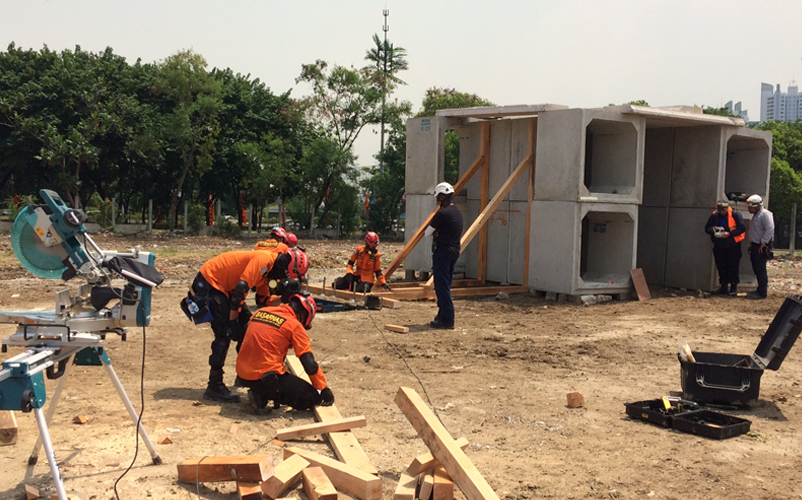The network of international search and rescue teams, International Search and Rescue Advisory Group (INSARAG), has had a classification system since 2005 known as the INSARAG External Classification (IEC). The purpose of IEC is to ensure that all the international urban search and rescue teams acquire the minimum operational standards set by INSARAG. The National Search and Rescue Agency (BASARNAS) of Indonesia is applying for IEC certification in November 2019 with support from Singapore. This paper reviews the IEC process for BASARNAS and critically evaluates the effectiveness of IEC as a tool for urban search and rescue capacity building. Through the preparation for IEC, the internationally deployed BASARNAS team successfully strengthened its search and rescue capabilities. The IEC process identified gaps in current levels of operation and INSARAG requirements. Having an IEC-classified team in Indonesia would lead to strengthening capability of domestic first responders.
Introduction
The INSARAG was established in 1991 from the lessons of the 1988 Armenian earthquake where the international teams could not operate effectively because of a lack of coordination. Under the United Nations umbrella, the group establishes specialised international urban search and rescue (USAR) to make emergency response and preparedness effective and to save more lives. International USAR teams are supported by guidelines on common procedures and organised meetings and exercises (Department of Humanitarian Affairs 1991).
INSARAG Guidelines were recognised by the United Nations General Assembly Resolution 57/150 as a reference for disaster preparedness and response. The Resolution encourages cooperation among member states to work on capacity building at all levels; internationally deployed teams as well as national and local first responders (United Nations General Assembly 2002). This was reiterated by the INSARAG Hyogo Declaration, adopted in 2010, that encouraged member states to support national and local capacity building efforts (INSARAG 2010). In addition, INSARAG, with support from the International Federation of Red Cross and Red Crescent Societies, developed the INSARAG First Responder Training Programme.
Since 2005, INSARAG has used a classification system, called INSARAG External Classification (IEC), to define and implement the minimum standards for international USAR teams (INSARAG 2015). Once IEC classified, search and rescue teams go through reclassification (IER) every five years. The INSARAG Hyogo Declaration encourages internationally deployed USAR teams to complete the IEC process and to adopt minimum operational standards. It also encourages receiving countries to prioritise using IEC-classified teams (INSARAG 2010). Although having an IEC certification is not mandatory, there are more than 50 teams already classified, and many teams are in the process of classification.
Although IEC has been established for 15 years, the effects of its introduction are not very clear despite the huge cost for international search and rescue deployments. In the 2015 Nepal earthquake, 16 people were rescued by international USAR teams, and 11 out of these 16 were rescued by the neighbouring Indian teams that were non-IEC-classified (Katoch 2015). IEC-classified teams did not arrive in Nepal sooner than non-classified teams. This indicates that assistance by IEC-classified teams was not prioritised to be sought by Nepal (Okita & Shaw 2019).
In general, there is a lack of studies on INSARAG and IEC effectiveness. Glassey (2013) conducted a study on INSARAG building markings applied during the Christchurch earthquake in 2011. The study analysed if responding teams adhered to INSARAG methodologies. However, the study did not differentiate between IEC-classified and non-IEC-classified teams (the New Zealand Government mainly received IEC-classified teams). Bookmiller (2015) points out that humanitarian relief, such as search and rescue and medical response, can be improved by responders adhering to professional and technical standards, including IEC. However, this is not supported by any actual case studies. Okita and colleagues (2018) compiled a case study on capacity building of Japan’s internationally deployed team through the IEC process. Japan is one of the most prepared countries for natural hazards and the damage they cause. The country already possesses skilled and trained teams. Case studies on the effects of IEC in less prepared and disaster-prone countries are worthy of examination.
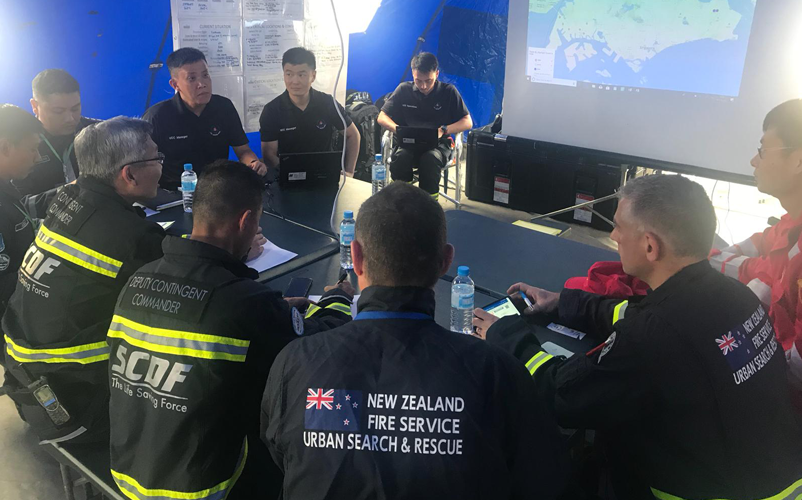
USAR teams conduct a coordination meeting at an On-Site Operations Coordination Centre during the IER for the Singapore Civil Defence Force in 2018.
Image: Yosuke Okita
The National Search and Rescue Agency (BASARNAS) of Indonesia is preparing for IEC in November 2019. This paper considered the effectiveness of IEC as a method to improve search and rescue capacity building. Putra (2019) conducted a study on the internal capacity building process of BASARNAS in accordance with INSARAG standards. Further to that, this paper focuses on how international support brought by IEC facilitates the capacity building process.
The certification process
To be classified in IEC and IER, USAR teams must meet the requirements listed in the IEC/IER Checklist as published in Volume II, Manual C of the guidelines developed by INSARAG. Checklist items are not limited to USAR techniques. Teams must establish arrangements for international deployment such as legal and logistical arrangements. They must also contribute to USAR coordination activities led by the United Nations Office for the Coordination of Humanitarian Affairs (OCHA) such as Reception/Departure Centre and On-Site Operations Coordination Centre.1 OCHA manages the website for the Virtual On-Site Operations Coordination Centre that enables responding officers to exchange information after a disaster happens. The IEC/IER Checklist requires USAR teams to use the Virtual On-Site Operations Coordination Centre.
During IEC/IER, USAR teams are classified as ‘heavy’ or ‘medium’ level teams depending on the scale of operations. For example, heavy teams must be able to conduct search and rescue operations for 24-hours at two separate sites for 10 days and must have the capability for both technical and canine search. Medium teams must operate for 24-hours at one site for seven days and should have either technical or canine search capability.
Before applying for IEC, USAR teams must be mentored from other IEC-classified teams or by highly experienced individuals. The mentor will assess the team and write a report about the team’s readiness for IEC. The team submits an Abbreviated Portfolio of Evidence (APoE) with the mentor report to the INSARAG Secretariat for assessment. The INSARAG Secretariat reviews the application and sets a tentative IEC date after two years. Approximately 10 months before the tentative date, the USAR team must submit a Comprehensive Portfolio of Evidence that includes many supporting documents such as training records and memoranda of understanding with partner organisations.
The IEC is a peer-review process and classifiers are engaged from IEC-classified teams to undertake assessments. During an IEC event, USAR teams conduct 36-hour field simulation exercises and the classifiers check the items against the Checklist and evaluate the work of each team.
Methodology
This research took a case-study approach and considered the IEC process for BASARNAS chronologically. BASARNAS attempted IEC certification in 2014 but that was postponed. They recommenced preparation in 2016 with support from Singapore as their mentor. BASARNAS is now targeting IEC in November 2019. This paper illustrates the difference in the two attempts.
In evaluating the effectiveness of IEC as a method for capacity building, the United Nations Environment Programme established six ways to improve the effectiveness of capacity building (United Nations Environment Programme 2006) (see Table 1).
Interviews with BASARNAS core staff and the mentoring team from Singapore were conducted during INSARAG-related events. These were the INSARAG regional exercise in the Philippines, IER in Singapore and BASARNAS exercise events held in Indonesia in 2018. The documents submitted by BASARNAS to the INSARAG Secretariat for the application for IEC were also reviewed.
Table 1: Ways to improve the effectiveness of capacity building.
| Ways to improve effectiveness | Description |
| 1. Identifying needs | Careful needs assessments are critical for priority setting and program design. |
| 2. Clear objectives | There is a need for a clear understanding of the objectives of capacity building between providers (of technical assistance) and beneficiaries. |
| 3. Capacity building approaches | A wide range of approaches is available to build capacities. Which approach will be most effective depends on the specific objective to be achieved. |
| 4. Target the right people | Avoid a situation where the focus is put on a limited group (e.g. senior government officials, decision-makers). |
| 5. Training of trainers | Providers can focus on training a smaller group of professionals who would be equipped to train others. |
| 6. Institutionalisation | Providers should focus on institutionalising capacity building programs at regional and national levels. |
Source: United Nations Environment Programme 2006
BASARNAS’s first IEC attempt, 2011–2014
BASARNAS has been very active in INSARAG activities since 2011, supported by strong leadership of the management at that time. In 2011, Indonesia, represented by BASARNAS, was selected as the Chair of the INSARAG Asia-Pacific Regional Group and hosted the Asia-Pacific regional meeting in Bali. At that time, BASARNAS started planning for IEC in 2014.
The increasing number of IEC/IER-classified USAR teams was becoming a challenge for the INSARAG network due to the heavy workload. The number of teams preparing for IEC increased and the existing IEC-classified teams started preparing for their five-year IER. In 2011, the Asia-Pacific region already had classified teams in Australia, China, Japan and Singapore, while Korea and another team from Australia were preparing for their IECs planned for 2012. The meeting discussed if the Asia-Pacific region should have more IEC teams or focus on capacity building of national USAR teams. The meeting reiterated that IEC was only for the internationally deployed teams (INSARAG 2011). It was difficult for the Asia-Pacific regional group to consider BASARNAS as an ‘international’ team because the team had only been deployed to the 2011 Great East Japan Earthquake.
In the regional meeting, an assessment of the current capacity of the Indonesian team as the first step of capacity building was agreed (INSARAG 2011). BASARNAS sought the support of the INSARAG Secretariat for the capacity assessment. The request was conveyed to the IEC-classified team in the Netherlands (USAR NL), which conducted the assessment in March 2012. While the main objective was to assess BASARNAS national search and rescue capability, USAR NL provided advice on IEC classification. With BASARNAS’s experience in responding to the disaster events within Indonesia, the USAR NL assessment team concluded that BASARNAS had certain skills but lacked other, necessary skills and equipment to conduct ‘urban’-type search and rescue activities. Other challenges were identified such as management structures and medical and logistical issues (USAR NL 2012).
Although USAR NL conducted the capacity assessment, it was not done as an IEC mentor. Teams must submit APoE together with a mentor report to obtain a tentative IEC date. BASARNAS did not have a mentor and thus could not submit the APoE. Their planned IEC in 2014 was automatically postponed.
BASARNAS’s second IEC attempt, 2016–2019
In 2016, BASARNAS recommenced preparation for IEC. BASARNAS approached the Singapore Civil Defence Force (SCDF), the only IEC-classified team in Southeast Asia region at that time, for support as the IEC mentor. SCDF appointed a mentor with rich experience in search and rescue who visited Indonesia in November 2016 for informal discussions. An initial assessment of BASARNAS was conducted in January 2017. The assessment involved observation of a table-top exercise, discussions with the stakeholders and visits to training sites, paying attention to deployment systems and procedures in accordance with the INSARAG Guidelines. The mentor assessment report was completed recommending BASARNAS for IEC classification consideration (Maideen 2017). BASARNAS submitted the APoE and the mentor report to the INSARAG Secretariat in February 2017 and received the tentative IEC date in 2019.
In preparing for the IEC, BASARNAS has actively hosted INSARAG-related events since 2016. Events have included the Reception/Departure Centre workshop in Jakarta in March 2016, the INSARAG Asia-Pacific regional exercise in Jogjakarta in June 2016, the INSARAG team leaders meeting in Bali in September 2017 and the USAR coordination course in Jogjakarta in October 2018.
According to the Deputy Director for Cooperation of BASARNAS, hosting the INSARAG events was very useful to train many of their staff at one time.2 While INSARAG regional exercises and the USAR coordination courses are held in other countries, only three or four participants from each country can attend. One of the mentoring team pointed out the benefits of hosting INSARAG events. The Indonesian Government was more aware of INSARAG and supported BASARNAS pursuing IEC classification.3
BASARNAS provided members to observe USAR teams in Korea in 2016 and the SCDF in Singapore in 2018 as IER observers. BASARNAS did not send any observers in their first attempt on IEC.
BASARNAS submitted the Comprehensive Portfolio of Evidence in January 2019 to the INSARAG secretariat. BASARNAS is pursuing a ‘medium’ classification but is planning to upgrade this classification to ‘heavy’ when they are reclassified in five years.
Achievements through the IEC process
The process of IEC presents opportunities to develop knowledge, skills and processes. BASARNAS achieved significant progress in vital structural areas.
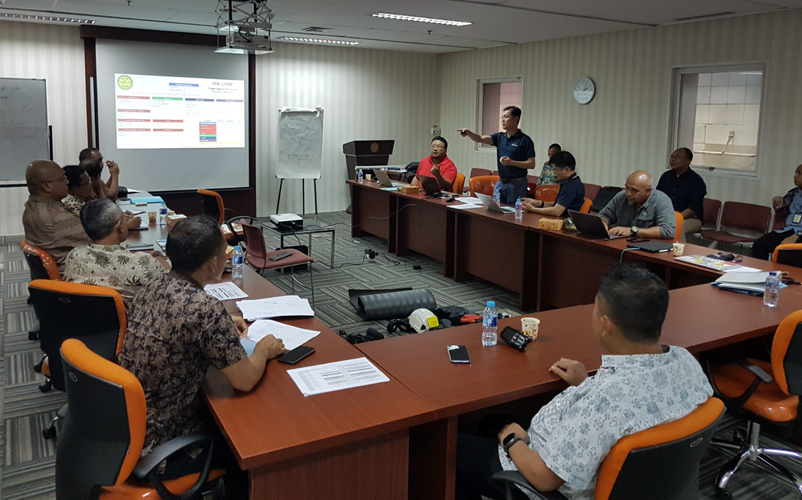
BASARNAS team members discussing team structure with the mentoring team from Singapore.
Image: Mirza Khan
Legal and logistical arrangements
The USAR NL assessment highlighted a lack of documentation required for classification (USAR NL 2012). BASARNAS had to show a legal authority to deploy teams internationally. To this end, the Law of the Indonesian Government Act No. 29 Year 2014 on Search and Rescue was made and is the basis for international deployment of BASARNAS teams (Indonesian Government 2014). According to BASARNAS, the Act provided a national policy and prioritised Indonesia’s contribution to international disaster relief activities. BASARNAS established a memorandum of understanding with the Indonesian Air Force for the use of aircraft for international deployments. As a backup, BASARNAS is negotiating similar arrangements with airlines such as Garuda Indonesia and Lion Air (BASARNAS 2019).
Team structure and personnel
To organise international team deployment, BASARNAS adopted a team structure with five components that align with the INSARAG Guidelines. These are management, search, rescue, medical and logistics (see Figure 1). The BASARNAS plan for international deployment is to meet the medium classification and, thus, deploy 57 personnel.
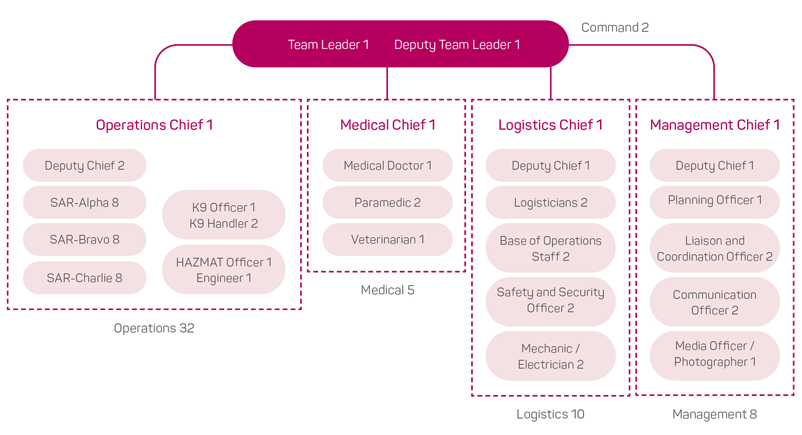
Figure 1: BASARNAS team structure to meet INSARAG medium-level team deployment.
Image: BASARNAS (2019)
USAR training
Capacity building of the BASARNAS was bolstered by additional equipment specific to search and rescue so teams can perform activities like mechanical shoring in shorter time and concrete breaching (cutting) to levels as specified in the IEC/IER Checklist. In addition, BASARNAS sent management and search and rescue personnel to SCDF for three intensive training sessions during 2018 for IEC preparation. In total, 64 staff completed the special training provided by SCDF (BASARNAS 2019). The mentor team also visited Indonesia to supervise exercises. For example, BASARNAS conducted a 36-hour simulation exercise in Jakarta in December 2018. The mentoring team evaluated the performance according to the IEC/IER Checklist. By then, the BASARNAS members were accustomed to using the newly introduced search and rescue equipment and the new training site was established in northern Jakarta.
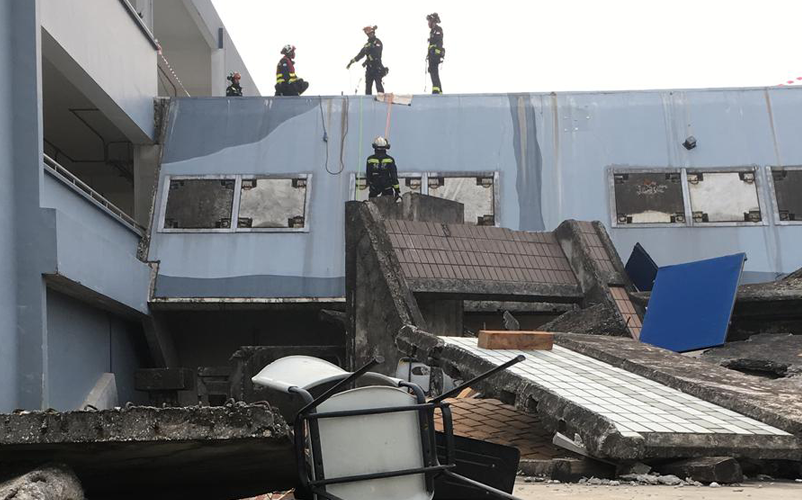
Simulation exercise during the IER for the Singapore Civil Defence Force in 2018.
Image: Yosuke Okita
Effects on domestic USAR teams
In January 2019, there were 3331 trained rescuers in BASARNAS headquarters as well as 38 search and rescue offices. A special unit, called BASARNAS Special Group (BSG), has 100 staff who are trained for complex rescue operations. The international deployment team is made up of officers from the headquarters and the BSG. This team represents three per cent of BASARNAS total search and rescue personnel (BASARNAS 2019).
In Indonesia, BASARNAS members from BSG team teach other BASARNAS personnel. BASARNAS established a certification system for domestic responders in 2018. In this system, BSG members are deployed to domestic training events as trainers and certify local rescuers so they are exposed to international standards and USAR techniques. BASARNAS also recruits new members for international deployment from regional teams.4 These arrangements ensure Indonesia has well-trained and well-qualified personnel to respond to emergencies and disasters.
In 2018, two major earthquakes hit Indonesia in Lombok and Sulawesi. In Lombok, although the Indonesian Government did not request international search and rescue assistance, BASARNAS put information on the BASARNAS response and their needs on the Virtual On-Site Operations Coordination Centre. This was done immediately as BASARNAS was following INSARAG methodologies and was the focal point for INSARAG in Indonesia.5 BASARNAS was also quick with deployment activities to the remote area. According to a medical doctor in BASARNAS who was deployed to the Lombok earthquake, the earthquake occurred at 18:46 (local time) and he got a call from BASARNAS at 20:00 to head to the military airport. At 04:00 the next day, loading had started and the team departed at 06:00. The 40-member USAR team, including the BSG members and six tonnes of equipment were transported by Indonesian Air Force aircraft to Lombok.6 Although not an international deployment, BASARNAS showed the ability to gather and deploy the BSG team and equipment within a short timeframe with support from its response partners.
Discussion
Table 2 summarises the actions taken by BASARNAS and their supporters as set out by the United Nations Environment Programme (2006) model on the effectiveness of capacity building.
Table 2 shows the IEC process facilitated the capacity building of BASARNAS. It helped them identify the gaps and ways to build team skills and capacities. It also motivated collaboration between BASARNAS members, the mentors and the government because of the shared goal. In this way, while IEC is designed as minimum and common standards for internationally deployed teams, the classification process led to the capacity building of domestic BASARNAS rescue personnel and systems.
This study indicates that the ‘cascading down’ effect of IEC does not always happen. BASARNAS developed a mechanism to translate INSARAG search and rescue techniques and standards to national and local levels in Indonesia. However, this mechanism is in its early stages and monitoring and future evaluation will better determine the achievements.
| Ways to improve effectiveness | Actions taken by BASARNAS and the supporters |
| 1. Identifying needs | The assessment conducted by USAR NL and SCDF identified gaps between BASARNAS operations and INSARAG standards (e.g. urban-specific search and rescue capabilities, logistical arrangement, documentation). |
| 2. Clear objectives | BASARNAS and the mentor shared a common goal: building international standard search and rescue capability based on fulfilling Checklist items for successful IEC. The training facility, the team structure and search and rescue equipment were obtained in accordance with the INSARAG Guidelines. |
| 3. Capacity building approaches | BASARNAS combined capacity building approaches (e.g. mentoring support, special training in Singapore for core members, hosting INSARAG-related events to train many of their staff) and used the IEC process to garner international support. |
| 4. Target the right people | Training opportunities were not limited to senior officials and decision-makers. |
|
5. Training of trainers 6. Institutionalisation |
The core BSG members who are trained for IEC classification trained the domestic rescue personnel with the domestic certification system. New BSG members are recruited from regional teams. |
Conclusion
The IEC process for BASARNAS was examined, and the standards that contribute to capacity building were identified. It is recognised that IEC activities contribute to the capacity building and establishment of effective USAR deployment systems. In this case study, BASARNAS introduced arrangements so that the international standards established by INSARAG and IEC become the national standards in Indonesia. In doing so, what was originally designed only for international teams can contribute significantly to domestic capacity building.
